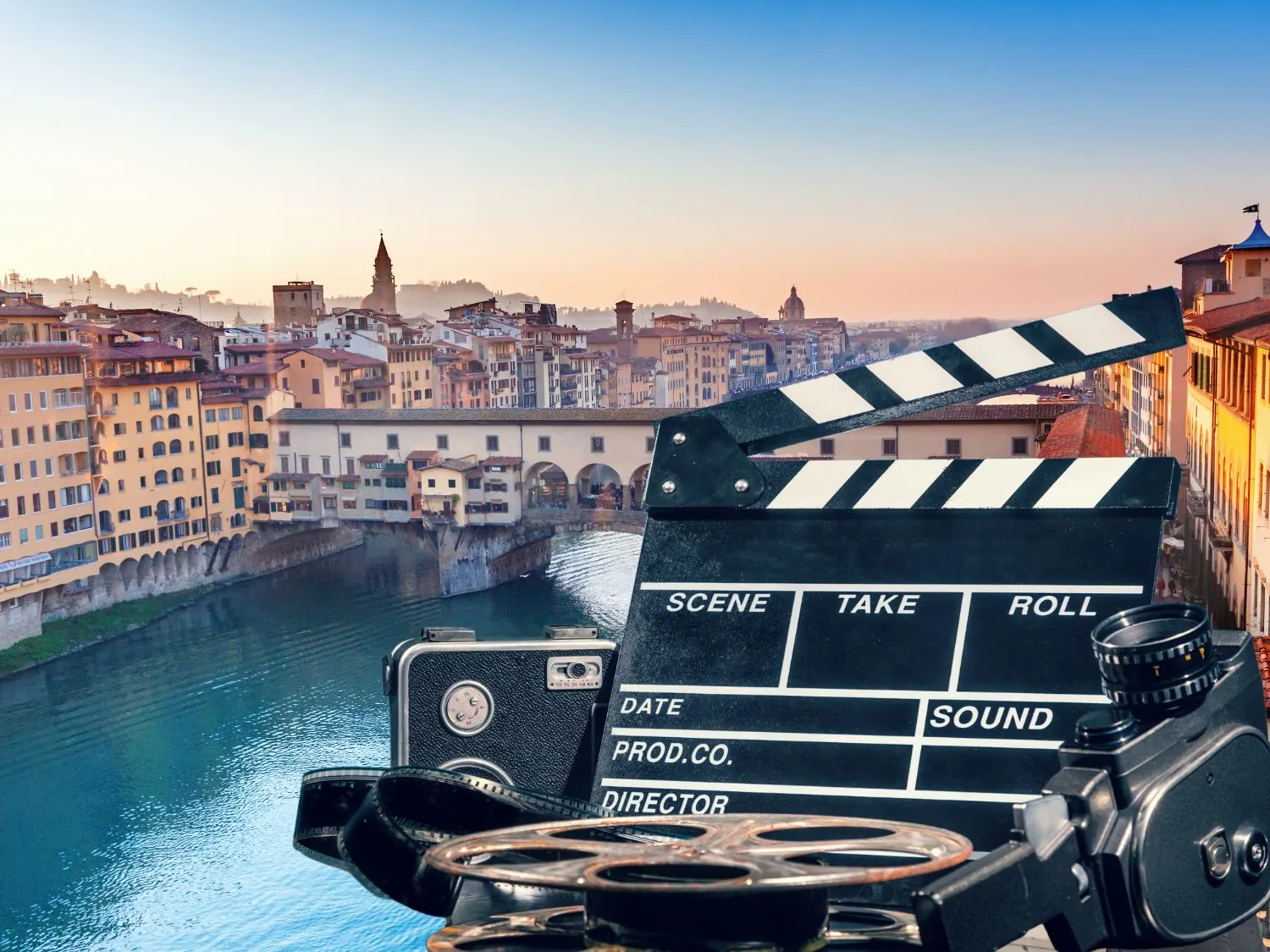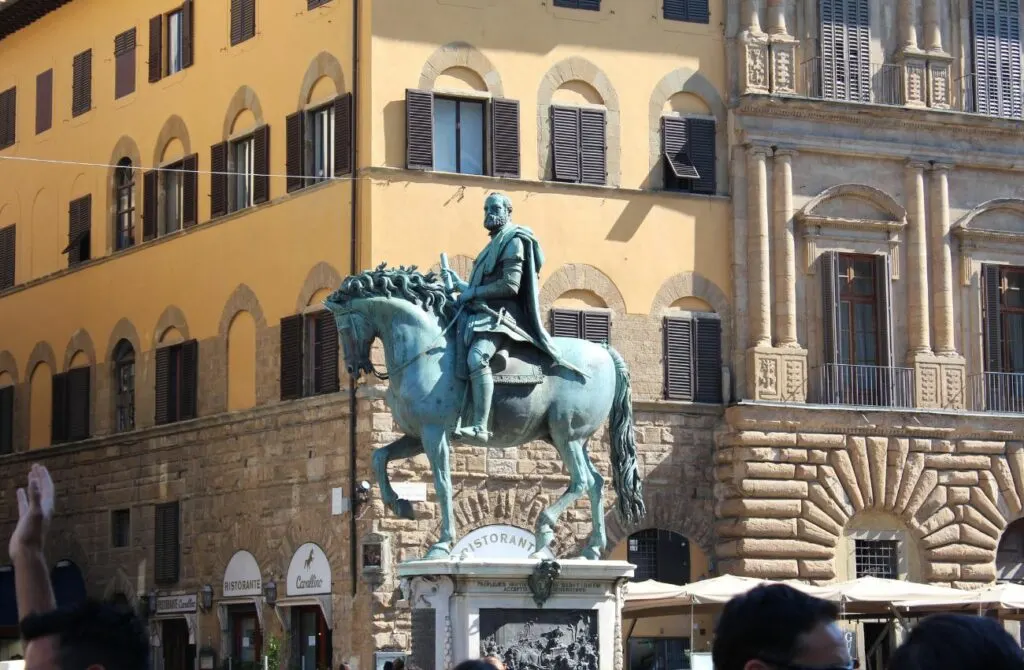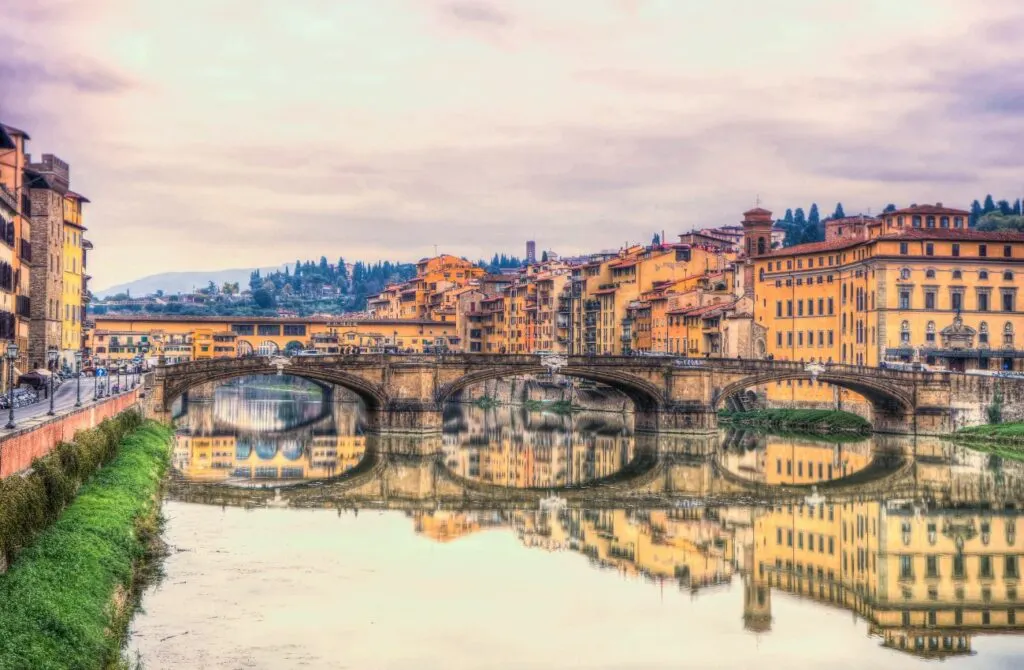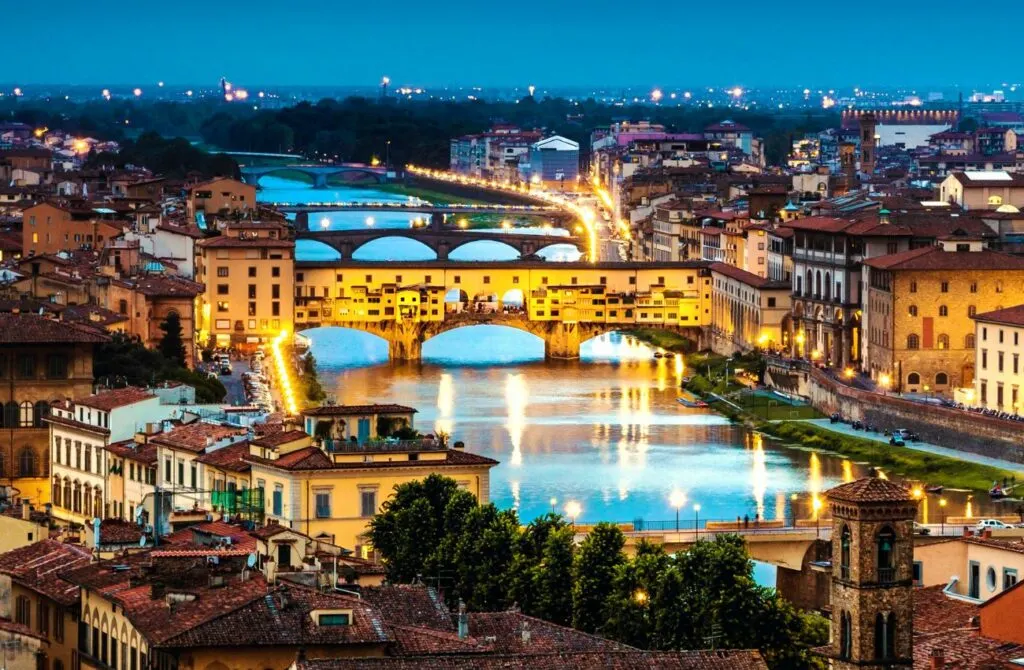Sofia De Vera combines a heartfelt passion for cinema with over 15 years of critiquing for esteemed film publications, wielding academic credentials from the University of Southern California and New York University, to serve as your personal guide through the enchanting worlds of film and television. Her full guest bio can be found here.
Florence has a lot to offer for both national and international filmmakers. The city is known for its Renaissance art and architecture, and famous galleries and museums. It is also well known for its culture and delicious cuisine. So it will come as no surprise that there are so many wonderful movies set in Florence.
Anyone who’s ever heard about Italy knows that Tuscany is its most beautiful region. An idyllic place where one can find vast expanses of green fields, taste the most delicious of foods, and indulge in wines that are as old and tasty as they get. And among the many beautiful cities that make up Tuscany, the one that both locals and tourists love the most is Florence.
While there are many beautiful cities in Europe, cities which hold a long history and rich culture, there’s no place quite like Florence.
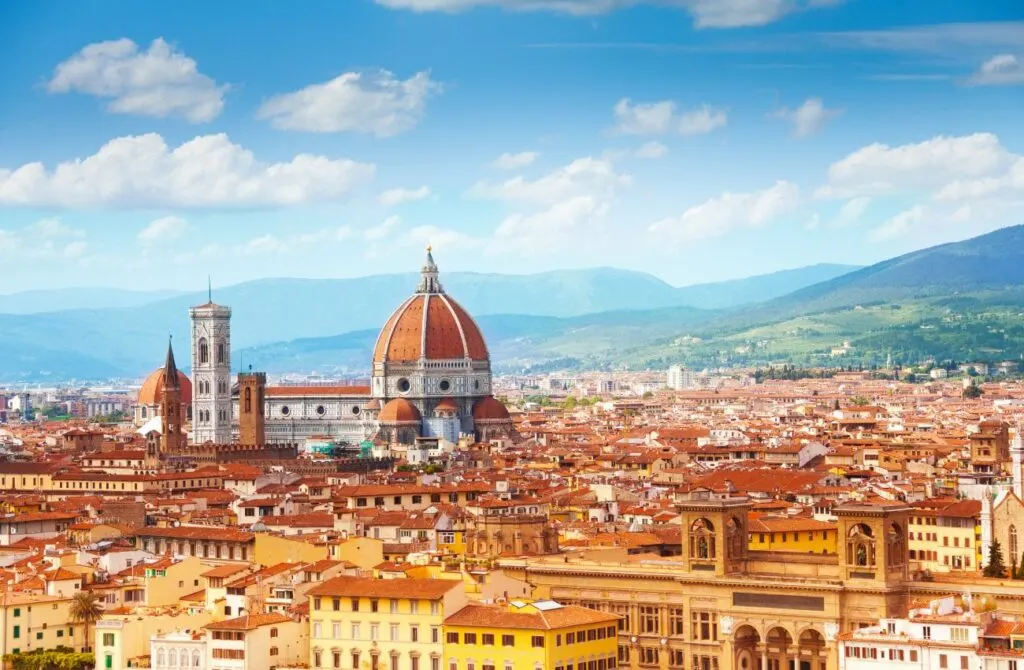
To this day the city is still a haven for artists from all kinds of disciplines. Among these, many filmmakers have found Florence to be a very inspiring subject. So there have been many films that weren’t only set in the city but also were about the city itself. Some of them are featured in this list, which ranges from one genre to the next, from the forties to just a couple of years ago.
These films set in Florence have narratives that rely on their settings as much as their main protagonists, and as a result, spectators get a glimpse of this iconic city through the director’s eyes. To honor the concept of cinematic travel, we have also assembled lists of our favorite films shot in some of our all-time favorite travel destinations: Budapest, Copenhagen, Rome, Berlin and Paris.
Wondering where to watch? It depends on where you live in the world and which streaming services you have. We link to the streaming service we watch on in each case - be it Netflix, Amazon Prime, Apple TV+, or elsewhere.
You can get one month free of Amazon Prime (or a 6-month trial for students) of Amazon Prime and also get immediate access to FREE Two Day shipping, Amazon Video, and Music. While you won't be charged for your free trial, you'll be upgraded to a paid membership plan automatically at the end of the trial period - though if you have already binged all these, you could just cancel before the trial ends.
Apple TV+ also has a one-week trial, and Hulu has a one-month trial (which can be bundled with Disney!). Another option might be using a VPN to access Netflix titles locked to other regions. Netflix is now available in more than 190 countries worldwide and each country has a different library and availability. US Netflix is (understandably) one of the best.
While we wish everything could just be in one place - for now, it seems these are the best streaming platforms to watch on.
Page Contents
Paisa [Paisà] (1946)
The time during and after the Second World War was devastating for Italy: the country was part of the losing side and fought to the last in order to keep its sovereignty over its home cities. Anyone who wasn’t part of the war was left to pick up the pieces of a broken country, trying to support the troops however they could.
Among the chaos and poverty that the war left behind, Italian filmmakers started to look for new ways to tell the things that they and their compatriots were experiencing. It was during this time that neorealist cinema was born.
This new way of making cinema consisted of telling realistic stories about poor and working-class people who had to struggle to get by, something that nobody thought would be interesting enough to put into a film.
While he wasn’t the inventor of the style, Roberto Rossellini is widely considered to be the one that made it internationally famous with his 1945 film Rome, Open City. This film, however, would only be the beginning of a trilogy produced in real-time as the war came to a close. Paisa is the second film in that trilogy.
Released just a few months after the war was over, the film shocked audiences with its depiction of the lives of the common soldiers in the Italian army. Paisa chronicles several real-life operations that these soldiers underwent: from the defense of Sicily and Naples, to the ongoing disputes on liberated Rome and Florence.
The film offers a unique perspective into the lives of those who are usually considered to be just bad guys. And it’s made all the more powerful by the fact that the ones behind the film were Italians themselves.
The Portrait of a Lady (1996)
If you’re really into British literature, you’ve probably heard about “The Portrait of a Lady“. This 1881 novel was one of the very best works by Henry James – and that’s saying a lot about the man who wrote “The Turn of The Screw”.
A story set in Europe, but mostly in London and Florence, the story of a young but wealthy American woman who had to deal with people who tried to take her money from her resonated with many folks back in the day.
The adaptation of the novel was directed by Jane Campion, who enjoyed a very successful season back when she won the Academy Award in 1993 for The Piano and who, more recently, enjoyed it again when she won the same award in 2021 for The Power of the Dog.
Even though she’s a two-time Academy Award winner, for a long time she’s been very much ignored by most audience members. Each of her films is worth watching. The Portrait of a Lady especially.
Like the book, the film tells the story of Isabel Archer (Nicole Kidman), a strong-willed and self-reliant young woman in 18th Century America. Lots of suitors desire Isabel, whether it be for her beauty or for her wealth (or the two of them at once), but she’s rejected lots of them again and again.
She’s distrustful of the men that approach her, so when her friend Madame Serena (Barbara Hershey) tells her she knows the perfect man for her, she decides to marry him. However, she will discover that this is all a ruse meant to steal Isabel’s wealth. Living in his husband’s Florence manor, Isabel will try to escape the situation she’s in.
Tea with Mussolini [Un tè con Mussolini] (1999)
You may be shocked by the title of this film, but rest assured it is one of the best movies set in Florence and that there’s more to what it seems. Tea with Mussolini is equal parts comedy, drama, and war film. It takes its initially silly premise of a group of women who regularly have tea in a coffee shop in Florence and uses it to explore the tough experience of immigrants who were living in Italy during the time of the Second World War.
Tea with Mussolini was directed by the late Italian director Franco Zeffirelli, widely known for his many adaptations of Shakespeare plays, including the 1968 Romeo and Juliet.
The film takes place in 1935 and follows its characters from the beginning of the war until its end in 1946. It tells the story of a group of immigrant English women who are living in Florence during the time that Benito Mussolini’s party became a mayor of Italian politics, eventually taking over the state through a dictatorship.
While Tea with Mussolini is a story about these women, its main character is not one of them. Instead, the movie’s protagonist is a young boy called Luca (Baird Wallace) who is in the care of one of the women, Mary Wallace (Joan Plowright), after the death of his mother and the uncaring nature of his father.
Tea with Mussolini is told through the eyes of Luca, who is included in the tea parties, over the years he watches as the fascists take control of the country. The women were often instigated at the start of the war because nobody knew which position England would take on the conflict. When everybody learned that England would be fighting against Italy, the lives of English immigrants in the country became much worse.
A Room with a View (1985)
A Room with a View is a romance film that tells the story of a young English lady who falls in love with a man while on a trip to Florence. The film was directed by James Ivory, whose earlier work may be familiar to you (Maurice, Howards End), but you’re definitely familiar with his most recent film: in 2017 he wrote the screenplay for Call Me by Your Name, which earned him an Academy Award for his adaptation, among several other awards in that category.
A Room with a View also did pretty well: both in terms of box-office and when it comes to awards. It won three of the eight Academy Awards it was nominated for, most notably Best Adapted Screenplay, as well as five BAFTAs and a Golden Globe. It’s considered to be one of the best English films of all time.
Like many of his movies, A Room with a View is an adaptation of a well-known book: in this case, it’s one by E. M. Forster. The film is a very faithful adaptation of the books, so fans of Forster’s work may be especially interested in this one.
Set in 1907, it follows Lucy Honeychurch (Helena Bonham Carter), a wealthy English lady from the Edwardian era who is spending her holidays with her chaperone in Florence. While staying in a pension, they meet a whole array of interesting characters who are also spending their time there.
Most notably among them is George Emerson (Julian Sands), a free-spirited man who little by little falls in love with Lucy. The movie sees them becoming close during the holiday and eventually consummating their love with a kiss. However, Lucy’s chaperone sees this and decides to take her back to England.
My Friends [Amici miei] (1975)
My Friends is one of Italy’s most beloved classic comedy films. Initially directed by the father of neorealism comedy, Pietro Germi, it was completed by Mario Monicelli upon Germi’s untimely death.
My Friends, as you may imagine, is a film about friendship, about those bonds that keep us together even when faced with the darkest of times. It is a hilarious comedy, which surprisingly holds up to this day, but it’s also a sentimental story about friendship and love.
The film follows four friends in their fifties living in Florence. There’s Necchi (Duilo Del Prete), who owns a café where they regularly meet; Mascetti (Ugo Tognazzi), who was once a noble and now has no money, but he still carries himself like a count; Perozzi (Philippe Noiret), a journalist who is constantly harassed by his family; and Melandri (Gastone Moschin), an architect in search for a partner.
The four of them try to stay connected with their child-selves by constantly playing pranks on everyone they meet. These are not any pranks: they take time, and preparation and usually involve dangerous stuff. Their latest idea was to make an unsuspecting man think that they are part of the mafia and constantly scare him. And they only do so because the man used to steal food from their café.
My Friends was filmed in the very streets of Florence, so anyone watching the film will get a good sense of what the city was like in the seventies. Many things have changed, but also others have not. You can still visit Piazza Demidoff, the square where the four friends meet to plan their pranks. While the same bar isn’t there, there are many like it.
I Vitelloni (1953)
Any list of Italian cinema and movies set in Florence would be incomplete without the mention of its most important creator: Federico Fellini. Known for his talent to tell the most fantastical of stories about the most regular of people, Fellini is one of the very best masters of cinema.
If you’re even barely acquainted with the history of international cinema, you are surely familiar with some of his most famous works: La Dolce Vita, 8 ½, and Amarcord. During his long and prolific career, Fellini garnered tons of awards, including sixteen Academy Award nominations and four wins (the most of any foreign language director).
He is, without a doubt, a force to be reckoned with when it comes to cinema. While I Vitelloni is one of his least known works, that doesn’t mean that it wasn’t a big success: it became a very popular comedy, won several awards, and marked the beginning of Alberto Sordi’s fame as an actor and comedian.
I Vitelloni (which could be translated to “The Slackers”) tells the story of five friends as they witness how their hometown is changing after the war. The fifties in Italy were marked by many changes, particularly when it comes to the values and beliefs that Italian society held. This process is outlined in the film through different vignettes.
Even though the story concerns these five young men, the film focuses especially on Fausto (Franco Fabrizi). He’s a charming womanizer who plays the role of the leader in the group. While the film isn’t set in Florence per se, all the shots of the town are actual shots of the least-known parts of the city, which makes this film a special opportunity to check out these places.
The Best of Youth [La meglio gioventù] (2003)
One of the most interesting works of film to come out of Italy in recent years, The Best of Youth tells a sprawling and mesmerizing story about the life of a middle-class family from the sixties to the early two-thousands.
It particularly focuses on Matteo (Alesso Boni) and Nicola (Luigi Lo Cascio), two brothers who time and time again are separated by the bigger conflicts that trouble the country through the years, but who always end up reuniting. The film chronicles the story of this family as some of them separate and some stick together in order to face the troubles that come their way.
You should be advised that The Best of Youth is a long film since it was initially planned as a television series. The film is a little over six hours long. The main way to see it, and the way it was released, it’s as two three-hour acts. But it has also been released as a four-episode television series. While this latter version is a little bit longer, it does add some good scenes that didn’t make it to the original cut.
The first part of The Best of Youth takes place in the summer of 1966, in Florence. The film begins with the two Carati brothers, who are planning to break their friend Giorgia (Jasmine Trinca) out of an asylum for the mentally ill where she’s constantly mistreated by those who are supposed to take care of her.
The two of them try to free Giorgia, putting their careers in medicine at risk, but they end up failing. This initial event will trigger the events that would shape their lives for the years to come.
The Stendhal Syndrome [La Sindrome di Stendhal] (1996)
The Stendhal Syndrome is a mystery thriller set in Florence, although it would be more accurately described as a Giallo film. For those unaware, Giallo is an Italian genre of movies that are equal parts psychological thriller and slasher horror. While it began as a literary genre, it was then adapted to the big screen, where it would really take off.
One of the most important filmmakers in the genre was Dario Argento, writer, and director of The Stendhal Syndrome. Widely considered to be the “Master of Horror”, Argento managed to combine luscious aesthetics with the most disturbing of stories. His best-known work was the 1977 Suspiria, which recently was remade by Luca Guadagnino.
While The Stendhal Syndrome is one of his lesser-known works, that doesn’t mean that it isn’t a great movie: most audiences and critics loved it and it still holds up to this day. The film follows a detective known as Anna Manni (played by Asia Argento, the director’s daughter) who is trying to track down a serial killer.
While visiting a museum, she finds herself suffering from Stendhal syndrome. This syndrome is a condition that can be triggered when in the presence of art: the observer enters into a dissociative state while admiring the art piece and it’s very difficult to take them out of this trance. The killer learns of this occurrence and uses it to his advantage, abducting the detective.
However, Anna will free herself and seemingly kill her captor. As days go by, however, she’ll become more and more suspicious of whether or not the killer is dead. What follows is a psychological thriller that will frighten even the most courageous of viewers.
Hannibal (2001)
It is safe to assume that most people are familiar with the terrifying character of Hannibal. This brilliant doctor in psychology who is also a serial cannibal has grazed the screen again and again through many adaptations: whether it be the original 1986 adaptation, the 1991 The Silence of the Lambs, the 2007 prequel, or the reboot 2013 series.
Every adult generation has had an incarnation of Hannibal to terrorize and entertain them at the same time. Even ten years before the release of the movie, the original books by Thomas Harris were a staple of the horror genre.
Each person is entitled to have a favorite incarnation of the character, but there’s no denying that Anthony Hopkins’ performance was so good that it set the tone for all the other adaptations to come. Of course, after such a great first film, people were left wanting more of Hannibal Lecter. And they got what they wanted.
Hannibal, by Ridley Scott, is the sequel to the successful 1991 film. The film follows Clarice Starling (Julianne Moore), an FBI agent who is sent on the trail of the cannibalistic serial killer by Mason Verger (Gary Oldman), his only surviving victim.
The film will follow Clarice as she locates Hannibal in Florence. There a thrilling hunt for the cannibal will take place, one involving not only Clarice but also the local police forces. As you may imagine, Hannibal’s smarts will allow him to evade his pursuers. He then goes back to Verger’s manor to finish what he started.
Inferno (2016)
It would be even safer to assume that most people have seen, read or know about The DaVinci Code. The best-selling novel by Dan Brown, which was adapted into an even more successful movie by Ron Howard, has made a mark in history as one of the most read stories ever.
While its sequels may have been neither as successful nor as good, they are still truly enjoyable films that offer viewers a chance to see some of the most captivating cities in the world. Just like The DaVinci Code was set in Paris and Angel and Demons in Rome, Inferno, the third and final film in the franchise, is set in Florence.
The film follows the last adventure of Robert Langdon (played by the always great Tom Hanks), a Harvard University professor of art history who is an expert in the use of symbology throughout history. This lends him the upper hand when facing some of the smartest and scheming villains in fiction history.
Inferno sees him waking up in Florence with no memory as to how or why he got there. He quickly finds out that he is suffering from amnesia because he was shot in the head with a bullet. With no time to think, Langdon escapes a new assassination attempt and tries to piece together the last few days through his belongings. That’s until he stumbles into the trail of Bertrand Zobrist (Ben Foster), a terrorist who was supposedly dead but whose plans to reduce the Earth’s population are still in motion.

